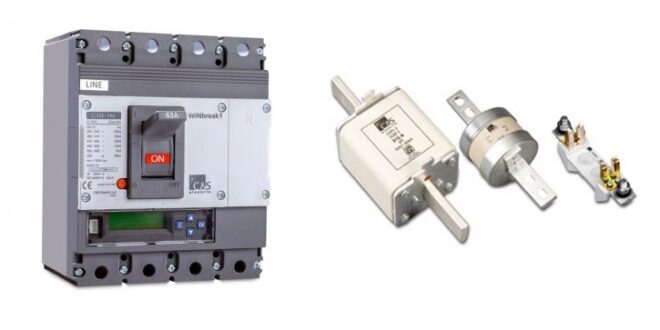What is the fuses and circuit breakers and how are they sized or selected
Fuses and circuit breakers
Fuses and circuit breakers are used to protect against short-circuit current, whose performance curve has two parts of protection, one against overload current and one against short-circuit current over. The fuses have two types of fast action (g) and slow action (am), where the slow action type is used for the electromotor and the fast action type is used for each type of consumer.
There are the following general types of circuit breakers:
– MCB (miniature circuit breaker)
– MCCB (molded case circuit breaker)
-MPCB (motor protection circuit breaker)
Miniature circuit breakers are mostly used for non-motorized items such as lighting or very small motors, and molded case circuit breakers can be used for many types of loads.
Note 1:
The miniature circuit breaker has a maximum cutting capacity of 10 kA, but there are fuses and molded case circuit breaker with higher cutting capacity.
Selecting and sizing fuses and breakers:
To choose a fuse and breaker, the rated current of the load must be calculated from the following relationship for three-phase loads:
I=P/(√3.V.cosq)
I: Rated current (amps)
P: power (watts): V: voltage (volts): Cosθ: power factor
After obtaining the nominal current and taking into account the temperature correction factor(if necessary), the size of the fuse and breaker is selected as below:
– Non-motorized loads:
For the fuse or breaker, that is placed directly before the load, the first fuse or breaker, with a standard nominal current that is higher than the load current is selected.
If the load is the electrical panel itself, a fuse or breaker with a higher range should be selected so that it does not interfere with the incoming breaker of that panel.
– Motor loads:
In the case that the fuse or the breaker is of the slow type or in the case of using the thermal breaker, it works the same as non-motorized loads.
In case of using the fast type, 2.5 times the rated current of the load should be calculated and the first fuse or breaker with a standard rated current that is higher than the obtained current should be selected. Because all breakers and fuses recognize 2.5 times their rated current as short circuit current and operate. As a result, considering of coefficient (2.5) and the fuse or breaker performance coefficient (2.5), the current will be equal to (6.25 = 2.5 x 2.5) times of the rated current, which is equivalent to the starting current of the electromotor, so they don’t work during starting time, and only cut the short circuit currents that are higher than this value.
Note 2:
For average voltages higher than 400 volts, the minimum range of fuses and breakers is 400 amperes. Therefore, you should use additional current protection relays along with them. In this case fuses and breakers are only responsible for protection against short circuit current and relays are responsible for protection against overload.
Selection of bimetal (thermal relay):
For the bimetal range, the nominal current equivalent of the related load will be selected.
 Ontrose industrial corporation Inc. Engineering and supply of industrial projects
Ontrose industrial corporation Inc. Engineering and supply of industrial projects




